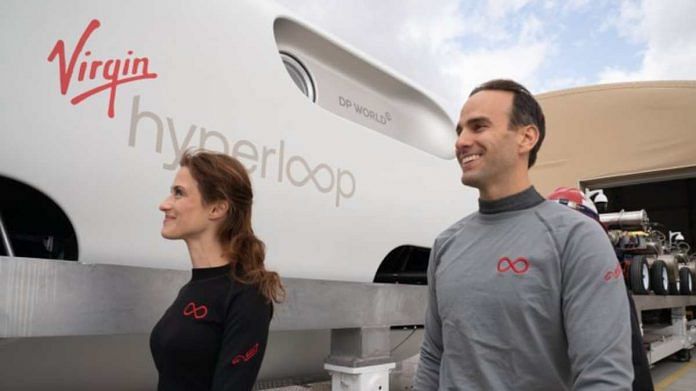Bengaluru: California-based futuristic transport company, Virgin Hyperloop Sunday performed its first successful test passenger run on a super high-speed levitating transportation system at the company’s DevLoop facility in Nevada. Two test passengers rode the second generation pod, called the XP-2 or Pegasus Pod, for 500 metres.
This is the company’s first crewed test — it had previously tested an empty passenger pod in 2017.
Hyperloop is a high-speed rail technology that aims to achieve transportation across long distances in a fraction of time taken today through magnetic levitation in low pressure vacuum tubes.
The technology can cut down travel times by hours. If the proposed system is built in India, it could cut travel between Mumbai and Pune to just 35 minutes, which by road takes around 3 hours.
ThePrint takes a look at the history and operation of the hyperloop technology.
Also read: China is making a Beijing-Tibet expressway and it has military implications for India
Concept and origin
Hyperloop works through the concept of shooting pods or compartments of passengers through an airtight tube that is in partial vacuum. The propulsion is done through magnetic levitation, with the air capsules or pods gliding or levitating over the tracks.
A maglev train system uses two sets of magnets — one for attracting and moving the train forward along the track, and another for repelling and pushing the train off the track.
The train travels along these guided magnetic rails, which can control the vehicle’s speed. Since there are no moving parts for any of the engine’s functionality, maglev trains are clean, smooth, almost noiseless, and can reach very high speeds.
Magnetic levitation was proposed as a concept at least a couple of centuries ago, as has the use of a pneumatic tube system for resistance-less, high-speed transportation. The idea of using magnetic levitation and high speed transit in the form of vacuum trains or vactrains has been a part of the public infrastructure debate for at least a century.
Development in the field has always hit a roadblock when it comes to eliminating air resistance and managing friction so as to optimise speeds. Maglev trains have managed to successfully eliminate both to a large extent, but traditional magnetic levitation systems have been hard to build and maintain due to cost of maintaining a vacuum.
Maglev public transportation has been adopted only in three countries — Japan, South Korea, and China. High-speed maglev trains run today only in China. The fastest maglev train is the Shanghai maglev train, which runs between Shanghai and its airport, covering a distance of 30 km in 7 minutes, hitting speeds of 430 kmph.
The idea for a company that would actively work on affordable and scalable maglev transportation in the form of a ‘hyperloop’ developed from a conversation that billionaire entrepreneur Elon Musk and now-disgraced investor Shervin Pishevar had in 2012, when the latter encouraged the former to develop working plans for such a technology.
Hyperloop’s journey
In 2013, Musk released a white paper for the Hyperloop Alpha technology to much acclaim and attention, and eventually set up Hyperloop One in Los Angeles in 2014. The company raised funds and expanded aggressively, performing tests and development of various components.
The Hyperloop Alpha technology was made open source, and several companies have since emerged, built on Musk and SpaceX’s original hyperloop idea.
In October 2017, Hyperloop One and the Virgin Group announced a strategic investment partnership with Richard Branson becoming the chairman of the board of directors.
A few months prior, Hyperloop One successfully tested one of the passenger pods but without any humans. The XP-1 passenger pod reached speeds of 192 kmph and levitated off the track as it flew through the tunnel for 300 metres.
The company has a number of active memorandum of understandings with governments and infrastructure development groups to construct hyperloop systems in countries such as the UAE, Saudi Arabia, Russia, Finland, Sweden, the Netherlands, the UK, Switzerland, and the US.
Hyperloop systems in India
In 2018, the Virgin Group and the Government of Maharashtra signed an agreement to build a hyperloop system between Mumbai and Pune. The current train time of approximately 3.5 hours and road time of nearly 3 hours is expected to be cut down to less than 35 minutes if and when Hyperloop One’s system in India is ready.
Another company, Hyperloop Transportation Technologies or Hyperloop TT, had signed an MoU with the Andhra Pradesh government in 2017 to develop a route between Amaravati and Vijayawada. The proposed project would cut down the 1-hour ride to just 5 minutes. However, there have been no public developments on the project.
The only Indian company working on developing a hyperloop technology is DGWHyperloop, which plans to build a hyperloop corridor between Delhi and Mumbai.
Also read: UAVs, high speed boats, All Terrain Vehicles — what Army’s Ladakh corps wants amid LAC row



